物流英语阅读理解十篇教学教材
最新中职商务英语阅读教案:ChapterTenLogistics
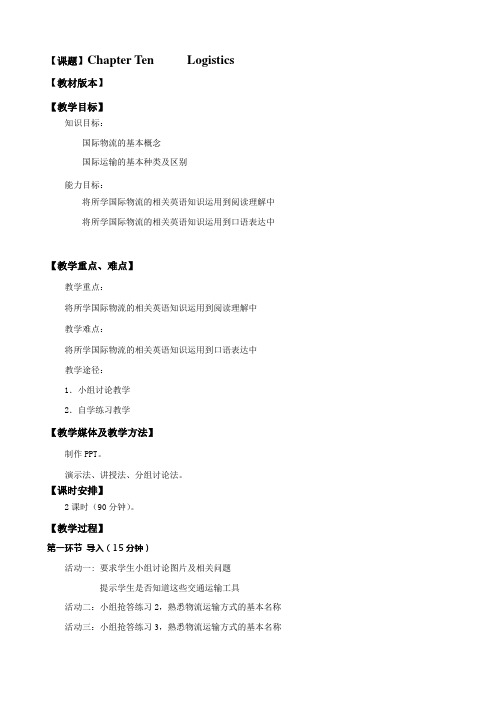
【教材版本】
Logistics
【教学目标】
知识目标: - 国际物流的基本概念 - 国际运输的基本种类及区别
能力目标: - 将所学国际物流的相关英语知识运用到阅读理解中 - 将所学国际物流的相关英语知识运用到口语表达中
【教学重点、难点】
教学重点: 将所学国际物流的相关英语知识运用到阅读理解中 教学难点: 将所学国际物流的相关英语知识运用到口语表达中 教学途径: 1.小组讨论教学 2.自学练习教学
第二环节 新授课(50 分钟)
阅读篇章 A [讲解] 详细讲解文章的内容 列出生词和长难句 [演示] 教师用幻灯片演示单词和句子 [问答]
How many types of shipment are there in the international trade? What are they?
[问答] 根据课文内容,小组抢答练习 5
【教学媒体及教学方法】
制作 PPT。 演示法、讲授法、分组讨论法。
【课时ห้องสมุดไป่ตู้排】
2 课时(90 分钟)。
【教学过程】
第一环节 导入(15 分钟) 活动一: 要求学生小组讨论图片及相关问题 提示学生是否知道这些交通运输工具 活动二:小组抢答练习 2,熟悉物流运输方式的基本名称 活动三:小组抢答练习 3,熟悉物流运输方式的基本名称
[问答] 小组抢答第 7 题
第三环节 课堂练习(15 分钟) [情景模拟] 要求学生分为 3 组,分别用 presentation 的方式介绍三种付款方式
第四环节 复习小结(8 分钟)
What is FOB, CIF, C&F
第五环节 布置作业(2 分钟) 默写第一篇阅读中的核心单词
01《物流专业英语》--Unit-1-What-is-logistics-第三版新编PPT课件
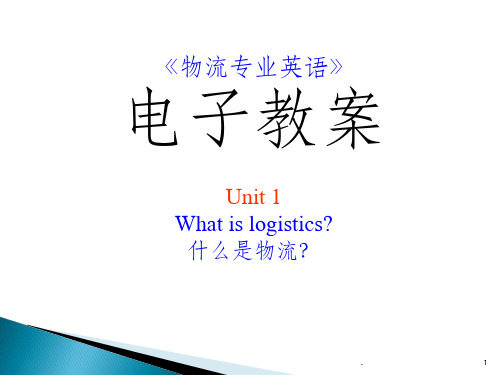
.
21
The Coca Cola soft drink product moves by the typical supply chain. The retail price is higher because value is added to the product as it passes through each node in the supply chain (Figure 2).
值得注意的是,人们,尤其是非专业人士,对物流有一种广泛 的误导性概念,即认为物流就是运输。的确,运输是物流 的核心构成部分,没有运输什么也动不起来。即使如此, 物流仍然比单独的运输所能传达的意义要深远得多。
.
16
How a bottle of Coca Cola coke moves to an end consumer 一瓶可乐是如何到达最终消费者手中的
If a consumer wants to have a bottle of Coca Cola coke, he can choose to:
如果客户想买一瓶可口可乐,他可能选择:
.
17
go straight to the manufacturer, buy it at ex-factory price (e.g. 1.50 Yuan/bottle) but pay extra costs for bus fare (e.g. 5 Yuan or more) , totaling 6.50 Yuan plus time cost (hours of bus travel), or
B选择是个人零散客户最常用的选择,在此种方式下,客户支付 较高的零售价,在享有较低的总成本的同时,还可以换取 购物的轻松并免除到厂家取货的耗时旅程。
高技物流英语全套教案

高技物流英语全套教案第一章:物流概述1.1 教学目标了解物流的定义、功能和分类掌握物流的基本概念和关键术语理解物流在供应链管理中的重要性1.2 教学内容物流的定义和功能物流的分类和基本概念物流在供应链管理中的作用1.3 教学方法讲授法:讲解物流的基本概念和分类案例分析法:分析实际案例,理解物流的应用1.4 教学资源教材:《物流英语》案例素材:物流企业案例1.5 教学活动导入:介绍物流的定义和功能讲解:详细讲解物流的分类和基本概念案例分析:分析物流企业案例,理解物流的应用1.6 教学评价课堂讨论:学生参与课堂讨论,提出问题和观点第二章:物流运输2.1 教学目标了解运输的定义和类型掌握运输方式的选择和评价理解运输在物流中的重要性2.2 教学内容运输的定义和类型运输方式的选择和评价运输在物流中的作用2.3 教学方法讲授法:讲解运输的定义和类型案例分析法:分析实际案例,理解运输的应用2.4 教学资源教材:《物流英语》案例素材:运输企业案例2.5 教学活动导入:介绍运输的定义和类型讲解:详细讲解运输方式的选择和评价案例分析:分析运输企业案例,理解运输的应用2.6 教学评价课堂讨论:学生参与课堂讨论,提出问题和观点第三章:物流仓储3.1 教学目标了解仓储的定义和类型掌握仓储管理的基本原则和方法理解仓储在物流中的重要性3.2 教学内容仓储的定义和类型仓储管理的基本原则和方法仓储在物流中的作用3.3 教学方法讲授法:讲解仓储的定义和类型案例分析法:分析实际案例,理解仓储的应用3.4 教学资源教材:《物流英语》案例素材:仓储企业案例3.5 教学活动导入:介绍仓储的定义和类型讲解:详细讲解仓储管理的基本原则和方法案例分析:分析仓储企业案例,理解仓储的应用3.6 教学评价课堂讨论:学生参与课堂讨论,提出问题和观点第四章:物流包装4.1 教学目标了解包装的定义和功能掌握包装材料的选择和评价理解包装在物流中的重要性4.2 教学内容包装的定义和功能包装材料的选择和评价包装在物流中的作用4.3 教学方法讲授法:讲解包装的定义和功能案例分析法:分析实际案例,理解包装的应用4.4 教学资源教材:《物流英语》案例素材:包装企业案例4.5 教学活动导入:介绍包装的定义和功能讲解:详细讲解包装材料的选择和评价案例分析:分析包装企业案例,理解包装的应用4.6 教学评价课堂讨论:学生参与课堂讨论,提出问题和观点第五章:物流配送5.1 教学目标了解配送的定义和类型掌握配送中心的管理和运作理解配送在物流中的重要性5.2 教学内容配送的定义和类型配送中心的管理和运作配送在物流中的作用5.3 教学方法讲授法:讲解配送的定义和类型案例分析法:分析实际案例,理解配送的应用5.4 教学资源教材:《物流英语》案例素材:配送中心案例5.5 教学活动第六章:物流信息系统6.1 教学目标了解物流信息系统的定义和功能掌握物流信息系统的组成和运作理解物流信息系统在物流管理中的重要性6.2 教学内容物流信息系统的定义和功能物流信息系统的组成和运作物流信息系统在物流管理中的应用6.3 教学方法讲授法:讲解物流信息系统的定义和功能案例分析法:分析实际案例,理解物流信息系统的应用6.4 教学资源教材:《物流英语》案例素材:物流信息系统案例6.5 教学活动导入:介绍物流信息系统的定义和功能讲解:详细讲解物流信息系统的组成和运作案例分析:分析物流信息系统案例,理解物流信息系统的应用6.6 教学评价课堂讨论:学生参与课堂讨论,提出问题和观点第七章:物流成本管理7.1 教学目标了解物流成本的定义和分类掌握物流成本计算和控制方法理解物流成本管理在物流中的重要性7.2 教学内容物流成本的定义和分类物流成本计算和控制方法物流成本管理在物流中的应用7.3 教学方法讲授法:讲解物流成本的定义和分类案例分析法:分析实际案例,理解物流成本管理的作用7.4 教学资源教材:《物流英语》案例素材:物流成本管理案例7.5 教学活动导入:介绍物流成本的定义和分类讲解:详细讲解物流成本计算和控制方法案例分析:分析物流成本管理案例,理解物流成本管理的作用7.6 教学评价课堂讨论:学生参与课堂讨论,提出问题和观点第八章:物流法律法规8.1 教学目标了解物流法律法规的定义和作用掌握物流法律法规的基本内容和原则理解物流法律法规在物流中的重要性8.2 教学内容物流法律法规的定义和作用物流法律法规的基本内容和原则物流法律法规在物流中的应用8.3 教学方法讲授法:讲解物流法律法规的定义和作用案例分析法:分析实际案例,理解物流法律法规的应用8.4 教学资源教材:《物流英语》案例素材:物流法律法规案例8.5 教学活动导入:介绍物流法律法规的定义和作用讲解:详细讲解物流法律法规的基本内容和原则案例分析:分析物流法律法规案例,理解物流法律法规的应用8.6 教学评价课堂讨论:学生参与课堂讨论,提出问题和观点第九章:物流客户服务9.1 教学目标了解物流客户服务的定义和目标掌握物流客户服务的基本原则和方法理解物流客户服务在物流中的重要性9.2 教学内容物流客户服务的定义和目标物流客户服务的基本原则和方法物流客户服务在物流中的应用9.3 教学方法讲授法:讲解物流客户服务的定义和目标案例分析法:分析实际案例,理解物流客户服务的应用9.4 教学资源教材:《物流英语》案例素材:物流客户服务案例9.5 教学活动导入:介绍物流客户服务的定义和目标讲解:详细讲解物流客户服务的基本原则和方法案例分析:分析物流客户服务案例,理解物流客户服务的应用9.6 教学评价课堂讨论:学生参与课堂讨论,提出问题和观点第十章:物流发展趋势与创新10.1 教学目标了解物流发展趋势的现状和未来掌握物流创新的基本方法和途径理解物流发展趋势与创新在物流中的重要性10.2 教学内容物流发展趋势的现状和未来物流创新的基本方法和途径物流发展趋势与创新在物流中的应用10.3 教学方法十一章:国际物流与供应链管理11.1 教学目标了解国际物流的定义和特点掌握国际物流的主要环节和操作流程理解国际物流与供应链管理的关系11.2 教学内容国际物流的定义和特点国际物流的主要环节和操作流程国际物流与供应链管理的融合与优化11.3 教学方法讲授法:讲解国际物流的定义和特点案例分析法:分析实际案例,理解国际物流的应用11.4 教学资源教材:《物流英语》案例素材:国际物流企业案例11.5 教学活动导入:介绍国际物流的定义和特点讲解:详细讲解国际物流的主要环节和操作流程案例分析:分析国际物流企业案例,理解国际物流的应用11.6 教学评价课堂讨论:学生参与课堂讨论,提出问题和观点十二章:绿色物流与可持续发展12.1 教学目标了解绿色物流的定义和原则掌握绿色物流的主要实践和案例理解绿色物流与可持续发展的关系12.2 教学内容绿色物流的定义和原则绿色物流的主要实践和案例绿色物流与可持续发展的融合与挑战12.3 教学方法讲授法:讲解绿色物流的定义和原则案例分析法:分析实际案例,理解绿色物流的应用12.4 教学资源教材:《物流英语》案例素材:绿色物流企业案例12.5 教学活动导入:介绍绿色物流的定义和原则讲解:详细讲解绿色物流的主要实践和案例案例分析:分析绿色物流企业案例,理解绿色物流的应用12.6 教学评价课堂讨论:学生参与课堂讨论,提出问题和观点十三章:物流安全与风险管理13.1 教学目标了解物流安全的定义和重要性掌握物流风险的识别和评估方法理解物流安全与风险管理的策略和实践物流安全的定义和重要性物流风险的识别和评估方法物流安全与风险管理的策略和实践13.3 教学方法讲授法:讲解物流安全的定义和重要性案例分析法:分析实际案例,理解物流安全与风险管理的作用13.4 教学资源教材:《物流英语》案例素材:物流安全与风险管理案例13.5 教学活动导入:介绍物流安全的定义和重要性讲解:详细讲解物流风险的识别和评估方法案例分析:分析物流安全与风险管理案例,理解物流安全与风险管理的作用13.6 教学评价课堂讨论:学生参与课堂讨论,提出问题和观点十四章:现代物流技术与管理14.1 教学目标了解现代物流技术的种类和应用掌握现代物流管理的基本理论和方法理解现代物流技术与管理的发展趋势现代物流技术的种类和应用现代物流管理的基本理论和方法现代物流技术与管理的发展趋势14.3 教学方法讲授法:讲解现代物流技术的种类和应用案例分析法:分析实际案例,理解现代物流技术的应用14.4 教学资源教材:《物流英语》案例素材:现代物流技术应用案例14.5 教学活动导入:介绍现代物流技术的种类和应用讲解:详细讲解现代物流管理的基本理论和方法案例分析:分析现代物流技术应用案例,理解现代物流技术的应用14.6 教学评价课堂讨论:学生参与课堂讨论,提出问题和观点十五章:物流职业素养与就业指导15.1 教学目标了解物流职业素养的要求和内容掌握物流职业发展规划的方法和步骤理解重点和难点解析本文主要介绍了高技物流英语全套教案,包括物流概述、物流运输、物流仓储、物流包装、物流配送、物流信息系统、物流成本管理、物流法律法规、物流客户服务、物流发展趋势与创新、国际物流与供应链管理、绿色物流与可持续发展、物流安全与风险管理、现代物流技术与管理、物流职业素养与就业指导等十五个章节。
商务英语阅读(下册)(第二版) unit 8 快递公司

In 1988, UPS commenced its operations in China through an agent partnership relationship with China's biggest freight forwarder, China National Foreign Trade Transportation Group, widely known as Sinotrans. In its first move, UPS started offering express delivery of small packages and documents. As per the agreement, UPS delivered the packages/documents to China while Sinotrans was responsible for delivering the packages in China.
Language points
FedEx
联邦快递公司的前身为FDX公司,是一家环球运输、物流、 电子商务和供应管理服务供应商。该公司通过各子公司的 独立网络,向客户提供一体化的业务解决方案。其子公司 包括FedEX Express(经营速递业务)、FedEX Ground(经 营包装与地面送货服务)、FedEX Custom Critical(经营 高速运输投递服务)、FedEX Global(经营综合性的物流、 技术和运输服务)以及Viking Freight(美国西部的小型运 输公司)
物流英语 text10

Marks can be preprinted on fiberboard boxes, or glued, stamped or stenciled on to containers. Brand labeling packages can aid in advertising for the product’s producer, packer and/or shippers.
4. The symbols must never be omitted as they are self-explanatory and so overcome language problems in international transport operations.4 这 些符号不能省略,因为它们传达了明确的意思而不 需要加以文字说明,所以克服了在国际运输作业中 的语言障碍。
Text 10:
Package Marking
Key Terms label 标签 shipping mark 运输标志 identification mark 识别标志 information mark 信息标志 handling instructions 储运标志 country of origin 原产国 dimensions of package 包装尺寸
Functions of Marking
Adequate marking (or labeling) is an essential component of the package. The mark or label is the text printed on a product package or, in the case of items like clothing, attached to the product itself. Marking keep track of the product as it moves through the logistics system, and assists wholesalers and retailers in using proper practices.
2022-2023学年(中职)物流英语.第一版Lesson 3电子教案
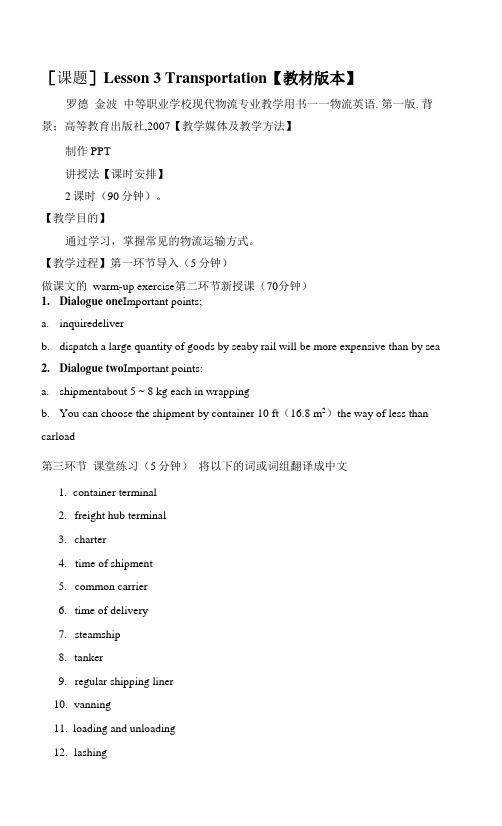
[课题]Lesson 3 Transportation【教材版本】罗德金波中等职业学校现代物流专业教学用书一一物流英语.第一版.背景;高等教育出版社,2007【教学媒体及教学方法】制作PPT讲授法【课时安排】2课时(90分钟)。
【教学目的】通过学习,掌握常见的物流运输方式。
【教学过程】第一环节导入(5分钟)做课文的warm-up exercise第二环节新授课(70分钟)1.Dialogue one Important points;a.inquiredeliverb.dispatch a large quantity of goods by seaby rail will be more expensive than by sea2.Dialogue two Important points:a.shipmentabout 5 ~ 8 kg each in wrappingb.You can choose the shipment by container 10 ft(16.8 m2)the way of less than carload第三环节课堂练习(5分钟)将以下的词或词组翻译成中文1.container terminal2.freight hub terminal3.charter4.time of shipmentmon carrier6.time of delivery7.steamship8.tanker9.regular shipping liner10.vanning11.loading and unloadingshing13.devanning14.FCL full container load15.LCL less than container load16.M/T measurement Ton17.W/T weight Ton18.optional port做课后练习P15 writing 1)第四环节小结(8分钟)学生必须掌握常见物流的基本英文表达:1)May I know what kind of your goods are to ship?2)You can choose the shipment by container 10ft.3)It takes less time and it's more convenient for customers.4)It needs 30 or 40 days to the destination port, (from the ETD) (ETD, estimated time ofdeparture)The more ports to call at, the more unable to estimate the time.5)According to weight ton or measurement ton, whichever is higher.6)The present freight on...7)US $ 60 per weight ton or measurement ton.8)They are without the service fee, insurance...9)How long could the goods be on route?10)Wc ask for the sea freight after shipment is made.第五环节布置作业(2分钟)使用课后练习(1)P15 writing 2), 3)P16 reading感谢您的支持与使用如果内容侵权请联系删除仅供教学交流使用。
Unit 2 Transportation《物流英语》教学课件
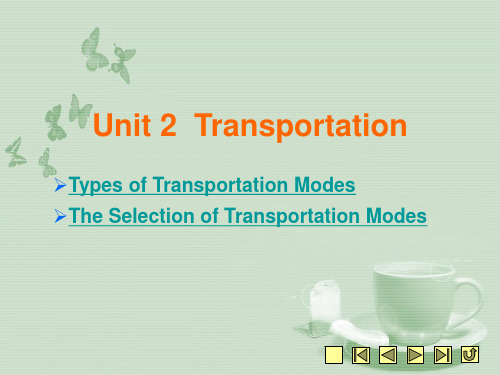
Ⅲ. Listen to the passage and fill in the blanks with what you exactly heard, the first letters have been given.
Generally speaking, containerization originated. from the United States and well organized in 1960s, developed in Japan in 1970s, boomed its development in South Korea in 1980s, and later boomed in China in 1990s.
be capable of sth 可以,容许;能胜任
vehicle /ˈvi:ikəl/ n. 交通工具,车辆
flexible /ˈfleksəbl/ adj. 灵活的;柔韧的
infrastructure /ˈinfrəˌstrʌktʃə/ n. 基础设施 investment /inˈvestmənt/ n. 投资 maintenance /ˈmeintinəns/ n. 维修;保养 significant /sigˈnifikənt/ adj. 相当数量的;意义重大的 fuel /fjuəl/ n. 燃料 congestion /kənˈdʒestʃən/ n. 拥挤
Reading
Text 1 Types of Transportation Modes
【Key Terms】
transportation mode 运输方式 road transport 公路运输 rail transport 铁路运输 water transport 水路运输 air transport 航空运输 pipeline transport 管道运输 maritime transport 海洋运输 river transport 内河运输
物流英语课件汇总全书电子教案完整版课件(最新)
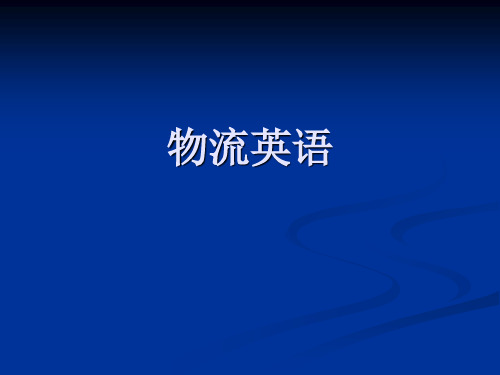
Task 1 Definition of Logistics and Main Functions
Words and Notes:
function n. 功能 representative n. 代表; 代表人 potential adj. 潜在的 container n. 集装箱 transportation n. 运输 warehouse v. 仓储,储存 consolidation n. 集货,配货
Project 1
Logistics and International Logistics
Your task:
Imagine you are a clerk of a logistics company, and now you are asked to introduce your company to your customer.
costs. Joseph:Please explain in detail.
Task 1 Definition of Logistics and
Main Functions
Wang Li:Of course, that was one of the best results achieved in the beginning of the 2000s.
Task 1 Definition of Logistics and Main Functions
freight n. 运输,运费 forward v. 发送,递送 substantially adv. 本质上;实质上 utilization n. 利用;使用 reputation n. 名誉;名声 implement v. 实施,执行;实现,使生效 inventory n. 存货,存货清单 salvage v. 抢救;海上救助 supply chain供应链
物流专业英语教学配套课件周晓晔徐剑chapter_1、2
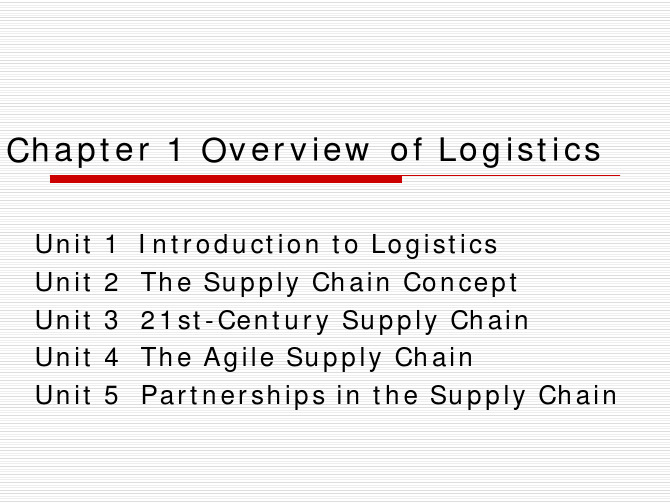
Packaging
Two purposes are served by packaging: promoting the product and protecting it.
Inventory
Inventory refers to stocks of goods that are maintained for a variety of purposes, such as for resale to others, as well as to support manufacturing or assemblinrvice
Customer service involves an array of activities to keep existing customers satisfied.
Demand Forecasting
Demand forecasting refers to efforts to estimate product demand in a future time period.
No other area of business operations involves the complexity or spans the geography of logistics. All around the globe, 24 hours of every day, 7 days a week, during 52 weeks a year, logistics is concerned with getting products and services where they are needed at the precise time desired. It is difficult to visualize accomplishing any marketing, manufacturing, or international commerce without logistics. Most consumers in highly developed industrial nations take a high level of logistical competency for granted.
Unit 10 Reverse Logistics 《物流英语》教学课件

3. Generally, in companies where the return rate. is greatest, much more effort has been spent in improving return processes.
4. Reverse logistics is more than reusing containers and recycling packing materials.
A: It was reported that an old man could earn more than 1,000 yuan a month only through collecting wastes .
B: Really? Were the wastes useful for him? A: No. The wastes are useless for the old man, but
1. A: Hello, did you watch the special program . yesterday on Channel Seven?
B: I had to do some extra work last night and missed that. But what was it about?
2. A: This is the Customer Service Center. Can I help you, madam?
B: I want to return the coat I bought last week. A: What’s the matter with the coat? B: The color faded when I washed it. But the shop
教学物流英语第一章

Originally, logistics is a military term, first used in the Napoleonic era. Logistics, as a military term, is defined as the art of moving armies and keeping them supplied. There are various definitions of different edition afterwards But in general, there are mainly two types of definition in practice.
organically the variety of the basic functional activities including transportation, storage, loading and unloading, package, distribution and information management, etc. (Other activities such as waste disposal, return goods handling, etc. are also important.)
物流英语讲课教案模板范文

课时:2课时年级:大学一年级教材:《物流英语》教学目标:1. 知识目标:- 学生能够掌握物流英语的基本术语和表达方式。
- 学生能够理解并运用物流英语中的常用句型。
- 学生能够阅读并翻译简单的物流英语文献。
2. 能力目标:- 学生能够通过听说读写活动提高英语实际运用能力。
- 学生能够在实际物流场景中运用英语进行交流。
3. 情感目标:- 培养学生对物流行业的兴趣,激发学习英语的动力。
- 增强学生的跨文化交际意识和团队协作能力。
教学重点:1. 物流英语的基本术语和表达方式。
2. 物流英语中的常用句型。
教学难点:1. 物流英语专业术语的发音和拼写。
2. 物流英语中的复杂句子结构和语法。
教学过程:第一课时一、导入1. 引导学生回顾上节课的内容,提问关于物流的基本概念。
2. 提出本节课的学习目标,让学生对课程内容有一个大致的了解。
二、新授课1. 介绍物流英语的基本术语,如:container(集装箱)、logistics(物流)、shipping(运输)等。
2. 通过图片、视频等形式展示物流行业的实际应用场景,让学生对物流英语有直观的认识。
3. 教授常用句型,如:- What kind of goods are you transporting?- How long does it take to deliver the goods?- Can you provide us with a tracking number?4. 学生跟读并模仿,教师纠正发音。
三、练习1. 学生进行小组讨论,用所学句型进行角色扮演,模拟物流场景。
2. 教师选取典型场景,进行口语练习,检查学生的掌握情况。
第二课时一、复习1. 复习上节课学习的物流英语基本术语和句型。
2. 学生进行自我检测,巩固所学知识。
二、深化讲解1. 深入讲解物流英语中的复杂句子结构和语法,如:被动语态、虚拟语气等。
2. 结合实际案例,讲解物流英语中的专业词汇和短语。
物流专业英语教案

物流专业英语教案教案标题:物流专业英语教案教案目标:1. 帮助学生掌握物流专业英语词汇和表达方式。
2. 培养学生在物流领域应用英语的能力。
3. 提高学生的听、说、读、写能力。
教学内容:1. 物流专业英语词汇和短语。
2. 物流领域的常见对话和表达方式。
3. 物流相关的阅读材料和写作练习。
教学步骤:Step 1: 词汇学习- 教师介绍物流专业常用英语词汇和短语,如"supply chain," "inventory management," "freight forwarding," "warehousing," 等等。
- 学生跟读和模仿,并进行词汇练习。
Step 2: 对话练习- 教师提供物流领域的对话情境,如货运协商、仓储管理等。
- 学生分组进行对话练习,模拟真实场景。
Step 3: 阅读理解- 教师提供一篇关于物流的短文,要求学生阅读并回答相关问题。
- 学生讨论答案,并进行语言表达练习。
Step 4: 写作练习- 教师提供一个物流相关的写作任务,如写一封物流合作信函或撰写物流报告。
- 学生完成写作任务,并进行互相批改和反馈。
Step 5: 教学巩固- 教师设计物流专业英语游戏或小测验,巩固学生所学内容。
- 学生参与游戏或小测验,并进行反馈和讨论。
Step 6: 课堂总结- 教师总结本节课所学内容,并强调学生在日常学习和实践中应用英语的重要性。
- 学生提出问题和反馈,教师进行解答和指导。
教学资源:1. 物流专业英语课本或教材。
2. 物流相关的阅读材料和案例。
3. 物流专业英语词汇卡片或手册。
4. 物流相关的对话情境练习题。
5. 物流写作任务的范例和指导。
评估方式:1. 口头表达能力的评估:通过对话练习和课堂讨论,评估学生的口语表达能力。
2. 阅读理解和写作能力的评估:通过阅读理解练习和写作任务,评估学生的阅读和写作能力。
十篇英语阅读理解

十篇英语阅读理解English reading comprehension is a crucial skill for academic and professional success. It involves the ability to understand, interpret, and analyze written texts in the English language. Reading comprehension skills are essential for students, researchers, and professionals across various fields, as they enable individuals to effectively understand and apply the information presented in written materials.In this essay, we will explore 10 English reading comprehension passages that cover a range of topics and demonstrate the diverse applications of this important skill.Passage 1: The History of the AutomobileThis passage traces the evolution of the automobile from its early beginnings to the present day. It discusses the key technological advancements that have shaped the automotive industry, such as the development of the internal combustion engine, the introduction of mass production techniques, and the emergence of electric and hybrid vehicles. The passage also examines the social and economicimpact of the automobile on modern society, including its role in shaping urban development, changing transportation patterns, and influencing consumer behavior.Passage 2: The Science of SleepThis passage explores the science of sleep, delving into the physiological and neurological processes that govern our sleep-wake cycles. It explains the different stages of sleep, including REM (rapid eye movement) and non-REM sleep, and their respective functions in cognitive processing, memory consolidation, and physical restoration. The passage also discusses the importance of sleep for overall health and well-being, and addresses common sleep disorders and their potential causes and treatments.Passage 3: The Rise of Artificial IntelligenceThis passage examines the rapid advancement of artificial intelligence (AI) and its far-reaching implications for various industries and aspects of society. It covers the fundamental principles of AI, including machine learning, neural networks, and natural language processing, and discusses how these technologies are being applied in fields such as healthcare, finance, transportation, and consumer services. The passage also explores the ethical and societal concerns surrounding the increasing influence of AI, including issues of privacy, job displacement, and the need for responsible development and deployment of these technologies.Passage 4: The Global Impact of Climate ChangeThis passage delves into the global impact of climate change, highlighting the scientific evidence and the far-reaching consequences on the environment, ecosystems, and human populations. It examines the primary drivers of climate change, such as greenhouse gas emissions, deforestation, and unsustainable resource consumption, and discusses the potential effects on weather patterns, sea levels, biodiversity, and food security. The passage also explores the international efforts to mitigate and adapt to the challenges posed by climate change, including the Paris Agreement and the ongoing efforts to transition to renewable energy sources and sustainable practices.Passage 5: The Evolution of the InternetThis passage traces the evolution of the internet, from its origins as a military communication network to its current status as a ubiquitous global communication and information-sharing platform. It discusses the key technological advancements that have shaped the internet, including the development of the World Wide Web, the rise of social media and mobile connectivity, and the growth of cloud computing and big data. The passage also explores the societal and economic impacts of the internet, such as its influence on communication, commerce, education, and entertainment, as well as the challenges it poses in terms of privacy, security, and digital divides.Passage 6: The Science of NutritionThis passage delves into the science of nutrition, examining the essential macronutrients (carbohydrates, proteins, and fats) and micronutrients (vitamins and minerals) required for human health and well-being. It discusses the metabolic processes involved in the digestion, absorption, and utilization of these nutrients, and how they contribute to various bodily functions, such as energy production, tissue repair, and immune system function. The passage also addresses the role of nutrition in the prevention and management of chronic diseases, such as heart disease, diabetes, and certain types of cancer, and the importance of maintaining a balanced diet and healthy lifestyle.Passage 7: The Psychology of Decision-MakingThis passage examines the psychological processes involved in decision-making, exploring the cognitive biases, heuristics, and emotional factors that influence our choices and judgments. It discusses the dual-process theory of decision-making, which suggests that we rely on both intuitive (System 1) and deliberative (System 2) thinking processes when making decisions. The passage also explores the impact of individual differences, such as personality traits and cognitive abilities, on decision-making styles, and the implications of these findings for various domains, including business, policymaking, and personal finance.Passage 8: The History of ArtThis passage provides an overview of the history of art, tracing the evolution of various artistic movements, styles, and techniques from ancient civilizations to the present day. It discusses the cultural, social, and technological factors that have shaped the development of art, such as the influence of religion, patronage, and technological advancements. The passage also examines the role of art in reflecting and shaping human experience, and the ways in which artists have grappled with themes of beauty, emotion, and the human condition throughout history.Passage 9: The Science of Exercise PhysiologyThis passage delves into the science of exercise physiology, exploring the physiological mechanisms and adaptations that occur in the human body during physical activity. It covers topics such as cardiovascular and respiratory responses to exercise, the role of muscle metabolism and energy systems, and the benefits of regular physical activity in maintaining overall health and fitness. The passage also discusses the principles of exercise training, including the concepts of intensity, duration, and frequency, and how these factors can be manipulated to achieve specific fitness goals.Passage 10: The Sociology of Gender and SexualityThis passage examines the sociological perspectives on gender andsexuality, exploring the social construction of these concepts and their influence on individual and societal experiences. It discusses the historical and cultural variations in gender norms and roles, as well as the ways in which gender and sexuality intersect with other social identities, such as race, class, and age. The passage also explores the societal attitudes and institutional structures that perpetuate gender-based discrimination and inequality, and the ongoing efforts to promote greater understanding, acceptance, and equity in these domains.These 10 English reading comprehension passages cover a diverse range of topics, from the history and science of various disciplines to the societal and cultural aspects of human experience. By engaging with these passages, readers can develop and enhance their ability to understand, interpret, and critically analyze written texts, which is a crucial skill for academic, professional, and personal success.。
- 1、下载文档前请自行甄别文档内容的完整性,平台不提供额外的编辑、内容补充、找答案等附加服务。
- 2、"仅部分预览"的文档,不可在线预览部分如存在完整性等问题,可反馈申请退款(可完整预览的文档不适用该条件!)。
- 3、如文档侵犯您的权益,请联系客服反馈,我们会尽快为您处理(人工客服工作时间:9:00-18:30)。
物流英语阅读理解十篇(一)After completing a commercial transaction, logistics will execute the transfer of goods from the supplier (seller) to the customer (buyer) in the most cost-effective manner. This is the definition of logistics. During the transfer process, hardware such as logistics facilities and equipment (logistics carriers) are needed, as well as information control and standardization. In addition, supports from the government and logistics association should be in place.Three major functions of logistics1.Creating time value: same goods can be valued differently at different times.Goods often stop during the transfer process, which is professionally called the storage of logistics. It creates the time value for goods.2.Creating location value: same goods can be valued differently at differentlocations. The value added during the transfer process is the location value oflogistics.3.Distribution processing Value: sometime logistics create distributionprocessing value, which changes the length, thickness and packages of thegoods. Like popular saying, “cutting into smaller parts “ is the most commonly seen distribution processing form. Most processing within logistics createadded value for goods.1.What is the meaning “cost-effective”? ( B )A.Cost reducedB.EconomicallyC.Cost evaluateD.To add cost2. (D ) creates time valueA. TransportationB. Good flowC. Different locationD. Storage3. What is the same meaning of location value? ( B )A. Different valueB. Different value of same goods at the different placesC. Different goodD. Different value of different goods at the same place4. What is the distribution processing value? (D)A. DistributionB. ProcessingC. Sales and processingD. Changing the length, thickness and the package of the goods5. The distribution process value is available in all logistics activities. Is it correct ornot? ( C )A.BothB.YesC.NotD.Not clear(二)An increasing number of companies are involving in international markets through exporting, licensing, joint ventures, and ownership. This trend should continue. With such expansion there is a need to develop worldwide logistics networks. Integrated logistics management and cost analysis will be more complex and difficult to manage.There are some future trends in internationalization:1. More logistics executives with international responsibilities.2. Expansion of the number and size of foreign trade zones.3. Reduction in the amount of international paperwork and documentation.4. More foreign warehousing is owned and controlled by the exporting firm.5. Increasing number of smaller firms.6. Foreign ownership of logistics service firms, e.g., public warehousing andtransportation carriers.7. Increasing multiple distribution channels.The international transport and the international logistics are same things in some way. So, when the international trading involved, the firm must establishinternational logistics systems to provide the products and services demanded.The most significant development in international logistics will be the increasing sophistication information system adopted and independent departments tooperate.1. What is the subject of the paragraph? ( C )A. The international tradeB. The international transportC. The international logisticsD. International economy2. What is the same meaning of “Internationalization”? ( B )A. NationalizationB. GlobalizationC. IntegrationD. Standardization3. What is the meaning of trend? ( A )A. General directionB. Developing roadC. WayD. Path4. The international transport and the international logistics are same. Is it corrector not? ( D )A. Not mention in the paragraphB. Not clearD. Right5. The international trade needs the ( B ) to fulfill its transaction.A. TrucksB. LogisticsC. ShipsD. Aircrafts(三)The characters of modern logistics are huge quantity, quick response and globalization. In order to meet the needs, information technology has become the brain to control them.Bar code, POS, EDI, GPS and internet are the main choices for the operation of logistics. Bar code system can get the goods information fast and exactly. By the data processing unit, POS system can check the inventory of warehouse at any time. When the super center adopts POS system, it can check the sales record, inventory even cash flow easily. EDI is a magic tool that can translate your documents into electronic data, sent it to your partner in any location by cable. In this way, we don’t need to make deal face-to-face. revise the documents, declare to customs before the shipments arrived, and more. Now, EDI is the most essential information tool for international trade and logistics. All of information tools are based on internet. In today’ s society, the organs of commercial and government, schools, even individual can make E-commerce with internet. So, Internet is the greatest revolution to influence the mankind.1. Information technology can help the operation of the logistics, but can’t changeits future.Is it correct or not? ( B )A.CorrectB.WrongC.In limited wayD.The role is not decided2. EDI is the core of information technology used in international trade andtransportation.Is it a fact? ( A )A.CorrectB.WrongC.Not mentionedD.Not clear3. What is the meaning of “magic tool” in the paragraph? ( D )A. VisibleB. InvisibleC. NetD. You can’t image it.4. What is most important information technology in the logistics? ( C )B. POSC. EDID. GPS5. Why is the Internet a great revolution? ( D )A. The newest scientific and technology inventionB. The most advanced technologyC. The valuable toolD. Helping the mankind greatly(四)If a shipper has a strict arrival and departure requirements, railroads are at a competitive disadvantage compared to motor carriers. Some of this disadvantage may be overcome through combined transport, which offers the economy of rail movement linked with the flexibility of trucking. Truck trailers are delivered to the rail terminals, where they are loaded on flatbed railcars. At the destination terminal they are off-loaded and delivered to the consignee-the customer who receivers the shipment.An additional area in which railroads suffer in comparison to motor carriers is equipment availability. Railroad lines use each other’s cars, and at times this equipment may not be located where it is most needed. Railcars may be unavailable because they are being loaded, unloaded, moved within railroad sorting yards, or undergoing repair. Other cars may be standing idle or lost within the vast rail network.A number of developments in the rail industry have helped to overcome some of these utilization problems. Advances have included: computer routing and scheduling; the upgrading of equipment, roadbeds, and terminals; improvements in railcar identification systems; and the use of unit trains, cars owned or leased by the shipper; and dedicated through-train service between major metropolitan areas (nonstop shipments of one or a few shippers’ products). Railroads own approximately 80 percent of their car fleet. The remaining 20 percent are either leased or owned by shippers.1. The disadvantage of rail transport compared with motor carrier is (D )A. CostB. SpeedC. Lost and damage ratiosD. Transit time and frequency of service2. The disadvantage above mentioned can be overcome by ( A )bined transportB.More frequencyC.Fast trainD.More flexible3. The advantage of rail transport is ( A )A. Great amount of shippedB. Less damage ratioC. Fast speed、exact schedule、cost savedD. Direct shipping line4. Railroads own about ( B ) of their car fleetA. HalfB. 80%C. 20%D. Not mentioned5. What is the meaning of Metropolitan areas? (D )A. Around the cityB. City itselfC. The area near the cityD. Big city and its neighbor area(五)Inventory can serve two basic functions:1. To provide a reserve for production and sales.2. To get the price discount by purchasing a large quantities.Inventory may be raw materials for the factory or finished products for the wholesaler and retailer. Most of inventory is placed in warehouse. Usually, three warehouses are available:1. Private warehouse. A private warehouse is owned and operated by a company. It is convenient to the owner who can store and process easily. For most factories and big traders, they often have large or small warehouse, more or less space to store goods.2. Public warehouse. Public Warehouse is developing for the Third Part Logistics and offers special services, including package and arrangement of delivery. Public warehouse has advantage of better service and lower cost than private one by its specialized equipment and marketing share.3. Contract warehouse. This kind of warehouse is formed and depended on the relation between the suppliers and customer.When buyer purchases goods, they don’t often ship them at the same time and store at the sellers’ warehouse. Warehouse equipment consists of folk lift truck, stacker, goods shelf and conveyor, etc.1. Inventory is the same as warehouse. Is it true or not? (B )A. Sometime yesB. NotC. No relation between themD. Different goods at different place2. Generally speaking, there are two kinds of inventory which are ( D )A. GoodsB. MaterialsC. Materials and productsD. Raw materials and finished products3. Public warehouse is most efficient. What is your opinion? ( A)A. Depend on the situationB. YesC. NotD. Not comparable4. Usually, contract warehouse doesn’t need to pay. Is it correct or not? ( C )A. YesB. NotC. It didn’t mention it.D. Sometime yes, sometime not.5 What is the equipment of warehouse?(D)A. ToolsB. Tools for handling, loading and unloadingC. Forklift truckD. Forklift truck and goods shelf(六)Managers in the last two decades have witnessed a period of change unparalleled in the history of the world, in terms of advances in technology, globalization of markets and stabilization of political economies. With the increasing number of “world-class” competitors both domestically and abroad, organizations have had to improve their internal processes rapidly in order to stay competitive. In the 1960s and 1970s, companies began to develop detailed market strategies, which focused on creating and capturing customer loyalty. Organizations also realized that strong engineering, design and manufacturing functions were necessary in order to support these market requirements. Design engineers had to be able to translate customer needs into product and service specifications, which then had to be produced at a high level of quality and at a reasonable cost. As the demand for new products escalated in the 1980s, manufacturing organizations were required to become increasingly flexible and responsive to modify existing products and processes or to develop new ones in order to meet ever-changing customer needs. As manufacturing capabilities improved in the 1990s, managers realized that material and service input from suppliers had a major impact on their organization’s ability to meet customer needs. This led to an increased focus on the supply base and the organization’s sourcing strategy. Managers also realized that producing a quality product was not enough. Getting the products to customers when, where, how, and in the quantity that they want, in a cost-effective manner, constituted an entirely new type of challenge. More recently, the era of the “Logistics Renaissance” was also born, recreating a whole set of time-reducing information technologies and logistics network aimed at meeting these challenges.As a result of these changes, organizations now find that it is no longer enough to manage their organizations. They must also be involved in the management of to manage their organizations. They must also be involved in the management of the network of all upstream firms that provide inputs (directly or indirectly), as well as the network of downstream firms responsible for delivery and after-market service ofthe product to the end customer. From this realization emerged the concept of the “supply chain”.见P781. When did the great changes take for the world economy? (B)A. 1970B. Last 20 years or moreC. Last centuryD. Long time ago2. What is the meaning of “customer loyally”? (A)A. The most important customers for any firmB. Loyal to companyC. The customers to buy a lotD. The long term customers3. What is the meaning of “Logistics Renaissance”? (A)A. Logistics began a new periodB. Logistics is rebornC. Logistics has taken economic functions much more beforeD. Logistics is developing4. What is the meaning of “Upstream” for supply chain? (B)A. CustomersB. SuppliersC. BuyersD. A and B5. What is the meaning of “Downstream” for supply chain? (A)A. CustomersB. SuppliersC. SellersD. B and C6. ( A ) is the place to store the goods imported or in transit, without paying dutyunder custom’s supervision.A. Boned warehouseB. Exported warehouseC. Imported warehouseD. Customs warehouse(七)All over the world, more and more ocean freights are carried out with containers. This trend will continue because containerized shipment offers so many advantages. Among them are:1. Economy. Overall transportation costs can be reduced by the container shipment. In the case of general cargo of 10,000 tons, it takes 48 hours to load andunload, but for the container ship of 35,000 tons, only 6-8 hour needed to load and unload.2. Safety. The cargo can be handled in any weather and is efficiently protected from theft and damage, because it is completely enclosed.3. Large scale. Container ship has become giant from 10,000 tons in 1970 to 100,000 tons, now it continues to grow bigger and bigger.There are two kinds of containers, 20’ and 40’, mostly adopted. And 20’container is called TEU, Twenty-foot Equivalent Unit, and standard container. One 40’ container is equal to two 20’s.Containers are used in ocean, railway and highway transportation. In recent years, many container terminals have been established. The continental bridge transport is introduced to load containers by trains. The road transportation follows this tendency, as the tractors pull the container with the speed of 100 km per hour in highway.1. What is container shipment? ( A )A. To load goods in containerB. Container is only choice for transportation.C. Containerized transportationD. Container ship, container train and container track2. What is containerization shipment? ( B)A. To load goods in containerB. Container is only choice for transportation.C. Containerized transportation.D. Container ship, container train and container track3. Only 20’ and 40’ container are available. Is it a fact? ( A)A. CorrectB. WrongC. Not mentionedD. I don’t know4. 20’ container is standard container. Is it true or not? ( A)A. YesB. NotC. It is old conceptD. It is new kind of container5. Container ships need the container terminal to load and unload goods. Is it corrector not? (C )A. CorrectB. WrongC. DependD. Not mentioned(八)Now, we discuss the relation between the international trade and logistics. As you know, trading involves several steps:1. Making deal. In this stage, the buyer and seller should negotiate the price ofthe goods, the way to pay, finally sign the contract.2. Payment. It is a core step in the trading. General speaking, buyers can not payto sellers directly. They usually ask their bank to write the Letter of Credit (L/C) tothe sellers. L/C is the promise to pay from the buyer, transferred to sellers’ band under the conditional articles.3. Transportation. After receiving qualified L/C, the seller begins to deliver the goods. Then transportation takes the main place of the trading. So, international transportation is similar word to international logistics. Logistics can move the commodities form one country to another with ships, trucks and air. Logistics may fix the cost of transportation to the trading partners with the terms of FOB and CIF. FOB means the deal price without insurance and freight. CIF contains cost of goods, insurance and freight. Transportation as the main function of the logistics has the very close relationship with foreign trade.4. Customs clearance and Inspection. In the final step, logistics helps customers and customs in two ways: on one hand, arrangement of goods to be cleared. on the other hand, handing in the documents to be examined.1. There is not close relationship between international trade and logistics. Is it correct?(B)A. CorrectB. WrongC. This is not main topic in the page.D. I don’t know2. What is contract? ( C )A. PaperB. ArrangementC. Arrangement by both sides of dealD. Memo3. L/C is a letter from buyer to seller. Is it true or not? (A)A. TrueB. YesC. CorrectD. Wrong4. What does customs do? ( A )A. Inspecting goods and collecting dutyB. Government organC. Collecting taxD. Inspecting commodities5. Does the author talk about the transportation equipment? ( B)A. YesB. NOC. Only a littleD. Dropping a hint(九)Transportation is the No. 1 function in the logistics. In certain way, transport equal logistics. There are five transportation modes: rail, highway, water, pipeline and air. The relative importance of each mode can be measured in the terms of mileage, load volume and income.1. Rail network. Rail network can be used to transport large tonnage goods over long distance. Rail companies have the advantage of low operation cost, like electricity and fuel, but the disadvantage of expensive investment.2. Motor Carriers. Highway transport has developed rapidly since 1970. The operation of door-to-door and flexibility are the main reasons why motor carriers can not be compared by other modes.3. Water Transport. Water Transport is the oldest way of transportation, but it is the only option for the international trading. Ocean ships can sail very long distance and extremely large shipments with the lowest cost. Recently, container ship may load 7,000 containers about 150,000 tons.4. Pipeline. Pipeline can send goods without stopping, but restricted to oil and gas. In 2003, China began to build three pipelines for water transportation called “water in Southern moved to Northern”.5. Air. Air freights is the newest and sun rise industry. Although it is high cost now, and the disaster of “9.11”, for a long run, air transport will increase its proportion steadily.1. Why is transportation the most important in the logistics? (D )A.It costs the longest time.B.It needs the most investmentC.It needs the biggest area.D.Its returned cost is the most.2. How many modes are there in the transport? ( C )A. 3B. 4C. 5D. More than 53. Which mode is the lowest cost in transportation? (C )A. TrainB. TruckC. Ocean shipD. Air4. What is the advantage of motor transportation? ( D )A. FastB. Save moneyC. EasyD. Flexibly and the operation of “door-to-door”5. Pipeline can only carry oil and gas. ( B ).A.NotB.YesD.Anything(十)Packaging is the end of production and the start of logistics. But it is more important to the latter than the former because the package is absolutely necessary to transportation and storage. Without it, the logistics can’t work. One of the basic functions of packaging is to protect the goods in the process of logistics. It is called industry package. The second function is to make sales easy. For example, a beautiful box of the shoes attracts the customer to buy. This is called commercial package.Packaging technology can be classified into two categories: one is package materials, the other is packaging methods. The materials consist of paper, plastic, wood, metal and glass. Paper is the biggest percentage of the packing materials. It can be used to make outer package, carton (paper box) and corrugated box. Paper is cheap, easy to shape and ventilated. Plastic is new fast developed materials, which is low cost, strong, good resistant to water, acid and so on. Wood has become the less proportion because of environmental protection. It is used to make the wooden box. Metal, exactly aluminum is to make cans for drinks, like COCA-COLA, which is easy to recycle. Glass is mainly used to fill the liquid, like chemical products and liquors. Packaging technique is to adopt several packing methods and containers to protect goods. For example, protection from damage and vibration is the basic packaging method. Protection containers have a lot, such as bag, box, can, bottle and barrel.1. Packaging is not a part of logistics. Is it true or not? (A)A.NotB.YesC.No relationD.Sometime yes, sometime not2. The main function of packaging is to protect goods. Do you agree? (B)A.YesB.NotC.DifferentD.Same3. There are two categories of packaging. Is it a fact? (D)A.MoreB. Only oneC. NotD. Yes4. Packaging material and technique are equally important to packaging technology. Do you agree? (C)A.DifferentB.Same effectC.YesD.No5. Packaging technique is the package shape. Is it a fact? (A)B.NotC.I don’ t knowD.No mention in it。
